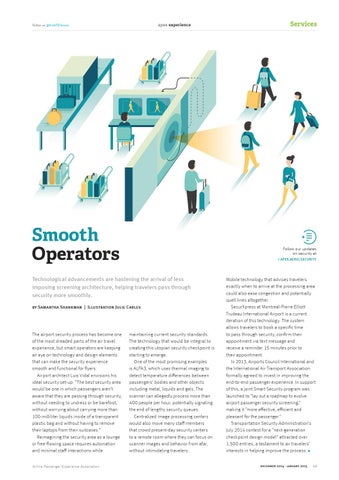apex experience
Follow us @theAPEXassoc
Smooth Operators
Follow our updates on security at > APEX.AERO/SECURITY
Technological advancements are hastening the arrival of less imposing screening architecture, helping travelers pass through security more smoothly. by Samantha Shankman | Illustration Julie Carles
The airport security process has become one of the most dreaded parts of the air travel experience, but smart operators are keeping an eye on technology and design elements that can make the security experience smooth and functional for flyers. Airport architect Luis Vidal envisions his ideal security set-up: “The best security area would be one in which passengers aren’t aware that they are passing through security, without needing to undress or be barefoot, without worrying about carrying more than 100-milliliter liquids inside of a transparent plastic bag and without having to remove their laptops from their suitcases.” Reimagining the security area as a lounge or free-flowing space requires automation and minimal staff interactions while Airline Passenger Experience Association
Services
maintaining current security standards. The technology that would be integral to creating this utopian security checkpoint is starting to emerge. One of the most promising examples is ALFA3, which uses thermal imaging to detect temperature differences between passengers’ bodies and other objects including metal, liquids and gels. The scanner can allegedly process more than 400 people per hour, potentially signaling the end of lengthy security queues. Centralized image processing centers would also move many staff members that crowd present-day security centers to a remote room where they can focus on scanner images and behavior from afar, without intimidating travelers.
Mobile technology that advises travelers exactly when to arrive at the processing area could also ease congestion and potentially quell lines altogether. SecurXpress at Montreal-Pierre Elliott Trudeau International Airport is a current iteration of this technology. The system allows travelers to book a specific time to pass through security, confirm their appointment via text message and receive a reminder 15 minutes prior to their appointment. In 2013, Airports Council International and the International Air Transport Association formally agreed to invest in improving the end-to-end passenger experience. In support of this, a joint Smart Security program was launched to “lay out a roadmap to evolve airport passenger security screening,” making it “more effective, efficient and pleasant for the passenger.” Transportation Security Administration’s July 2014 contest for a “next-generation checkpoint design model” attracted over 1,500 entries, a testament to air travelers’ interests in helping improve the process. december 2014 - january 2015
43
